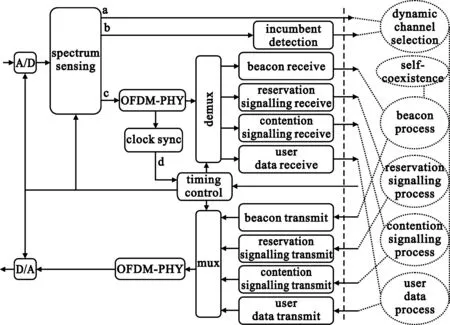WirelessNetworkBasedonECMA-392 Technology*
2014-09-07YANGDaquan
YANG Da-quan
(Alcatel-Lucent Shanghai Bell Co.,Ltd.,Shanghai 201206,China)
WirelessNetworkBasedonECMA-392Technology*
YANG Da-quan
(Alcatel-Lucent Shanghai Bell Co.,Ltd.,Shanghai 201206,China)
The standard ECMA-392 specifies a physical layer and a medium access sub-layer for wireless devices to operate in the TV frequency bands,wireless network working in TV white space(TVWS) has enhanced coverage range and robustness,and less power consumption.Based on the hardware of network devices using ECMA-392 technology including transceiver,digital signal process,and high level process module,control reference model based on MAC superframe structure is provided.A clock synchronization block is needed to make device synchronize in superframe period. An ECMA-392 network application established by TV broadcast operator is analyzed as an example.
cognitive radio;ECMA-392;TV white space;cognitive cellular;wireless network device
1 Introduction
As the use of wireless network devices like smart phones is increasing,wireless data traffic is booming,people want more spectrum to be used for wireless data communication. Consider that after analogue TV switchover to digital broadcast service,large of the TV spectrum will be released,many organizations are researching on the topic of how to use the TV white space (TVWS) for wireless data communication without harmful interference to the incumbents[1].
There are two types of standards that plan to use TVWS for wireless data communication,one is for fixed wide band wireless access in large region,like IEEE wireless regional area networks standard IEEE 802.22,maxim 4 W transmit power,up to 30 km coverage,one base station supports up to 512 customer premise equipment,customer premise equipment used as wireless access modem for customer local network,can be used for backhaul for network of things,wide band wireless coverage,and internet access service[2]. Another type of standard that plan to use TVWS for wireless data communication is suitable for local area data communication,like ECMA-392[3]from ECMA,with maxim transmit power only 100 mW,can be embeded into personal/portable electronics,home electronics equipment,and computers and peripherals,used for wireless data communication in buildings and neighborhood-area. Compared with the so-called Super WiFi,IEEE802.11af (standard still in draft),the ECMA-392 has better performance in case of single TV channel[4].
The remaining sections are organized as follows: The PHY layer specified by the ECMA-392 standard is presented in Section 2,shows the advantages of the wireless local area network. In Section 3 and 4,the hardware architecture and control reference model will be described. In Section 5,we will analyse the user terminal connection mode in ECMA-392 wireless network. Finally,we conclude this paper in Section 6.
2 ECMA-392 Phyfeatures
ECMA-392 is a standard for personal/portable electronics to work in TVWS,based on the research from Cognitive Networking Alliance (CogNeA),operation band is from 47 MHz to 910 MHz. The standard also had been adopted by ISO as ISO/IEC 16504.
The PHY of ECMA-392 is based on a 128 points FFT OFDM modulation for best compromise between overhead and performance. Among the 128 sub-carriers,102 sub-carriers are used,togeather with the DC sub-carrier,signal bandwidth occupies 103 sub-carriers. ECMA-392 PHY supports three types of modulation:QPSK,16-QAM and 64-QAM.In combination with different RS encoding,we can configure out 10 different data rates,spectral efficiency from 0.79 to 3.96 b/s·Hz-1. Table 1 shows different sub-carrier spacing under different channel bandwidth,corresponding signal bandwidth,minimal and maximal data rate.Under 6 MHz channel bandwidth,the ECMA-392 system minimal data rate is 4.75 Mb/s,maximal data rate is up to 23.74 Mb/s.

Table1 ECMA-392 OFDM bandwith patameters表1 ECMA-392 OFDM带宽参数
TV broadcastband has outstanding propagation characteristics,compared with ISM band in 2.4 GHz / 5.8 GHz,using TVWS can improve signal coverage and robust. Analysis shows that,when operating in 600 MHz frequency band,with transmit power at 100 mW,4.75 Mb/s can cover a range of 1 000 m,23.74 Mb/s can reach 100 m[5]. Further more,for a given range,the ability to operate at lower power-levels would result in better energy efficiencies. In addition,TVWS has abundance spectrum,which can help to solve the overcrowding situation in ISM bands. The industry of TV band RF hardware components is well matured,this will help the popularization of communication devices that operate in this band.
3 ECMA-392 Hardware Architecture
The ECMA-392 standard is planed to be used for personal/portable electronics and supports two basic network formation modes: the master-slave mode and the peer-to-peer mode. There will be two types major ECMA-392 devices: one type is used for network backhaul,normally is the master device in master-slave mode,or backhaul node in peer-to-peer mode,the backhaul port will be an ethernet or a USB port; the other type device do not need to do backhaul,normally is the slave device in master-slave mode,or normal node in peer-to-peer mode,the ECMA-293 protocol process unit uses standard on-board bus (e.g USB bus) or directly processor local bus to connect to the device function process unit. Thus,we can divide ECMA-392 device into three catalog: Catalog I ——backhaul device (wireless access point style); Catalog II——standard on-board bus device (wireless LAN card style),and Catalog III——function and transportation all-in-one devide. Each catalog of ECMA-392 device has almost the same hardware related with ECMA-392,including transceiver,digital signal process,and high level process,etc,as showed in Fig.1.

Fig.1 ECMA-392 device hardware architecture
In Fig.1,the ECMA-392 transceiver will be a wide bandwidth transceiver,and must be tunable at steps of 6 MHz (or 7 MHz/8 MHz),the architecture can be heterodyne or homodyne[6-7]. Digital signal process part is designed to implement PHY function and part of MAC function,including channel coding/decoding,mapping/demapping,FFT/IFFT,cyclic prefix inserting/removing,and network synchronization,MAC frame FCS check,frame management,and transmit/receive tdd switch,etc,chips like FPGA and DSP devices can be used,maybe there will be ASIC for these function after years. The high level process will be implemented by a general purpose processor,whose functions include part of MAC function and cooperation with other part of the device(beacon process,signalling process,user data process,and spectrum sensing,incumbent protection management,self-coexistence management,coexistence with other network management,etc). Besides ECMA-392 function,the general purpose processor will also implement other function,like backhaul bridge and router (Catalog I device),user data transportation (Catalog II device),or user data generation and process (Catalog III device).
4 ECMA Device Reference Model
The ECMA-392 device uses 128 ms recurring superframe as its basic MAC frame exchange struture,each superframe starts with beacon period (BP),end with contention signalling window (CSW),between them are reservation based signalling window (RSW,only in master-slave mode) and data transfer period (DTP).Signalling windows and beacon period are used for sending and receiving control/management information,data transfer period is used for sending and receiving user data. Consider that BP,RSW,DTP and CSW have different transmit/receive control method,we can use independent procedure for each one,Fig.2 shows a control reference model based on MAC superframe struture.

Fig.2 ECMA-392 device control reference model
In receiving direction,digitalized received data is first put into spectum sensing block,the spectum sensing block is used to detect the channel usability,when conflicting with incumbents or other unlicensed users (line a),device will start dynamic channel selection procedure,try to select other channel. When channel is usable,received data will flow into PHY process (line c) to recover MAC data,and set up clock synchronization at the same time. The recovered MAC data,sequenced by time,will be put into beacon process block (including self-coexistence process),reservation based signalling process block,user data process block,and contention signalling process block. In receiving period,there is also a quiet period detection function (line b),used to do incumbent user detection in real time,when incumbents detected,device will start transmit power control and dynamic channel selection to protect incumbents. The transmitting direction is opposite with receiving direction,beacon,reservation based signalling,user data,and contention signalling will be put into PHY follow time sequence,then converted to analog signal.
The clock synchronization block is a key module in the control reference model. In an ECMA-392 superframe peroid,there will be many transmit-to-receive or/and receive-to-transmit transition states,Fig.3 shows in the possible status a device will be in each superframe phases,transition points will be up to 8 in a superframe period. To synchronize transmit and receive switch between devices,transition gap and device synchronization should be set up. The ECMA-392 device uses a ± 20 ppm local oscillator as symbol clock,to make high level device synchronization,a clock synchronization block is needed (line d). The device maintain a start time of a superframe,determines the difference between the expected beacon reception time and the beacon’s actual reception time,if the expected reception time is earlier than the actual reception time,then the neighbour device is slower,the reveived device will adjust maintained superframe start time so as to synchronization with the slowest device in the network.

Fig.3 ECMA-392 superframe transmit-receive transition points
5 ECMA-392 Wireless Network
Thanks to operation in TVWS frequency band,ECMA-392 network will be suitable for deliverying high reliability video stream inside home and across multiple walls, making robust coverage inside buildings and across campuses for wireless data applications,giving enhanced range for municipality internet access,providing enhanced range,robustness and quality for emergency-response and public service communication networks[4]. We can set up a wireless local network by using master device as wireless access point in master-slave mode,or we can set up a self-organizing, self-healing ad hoc network by using peer-to-peer mode. Fig.4 gives a example of ECMA-392 network application.

Fig.4 ECMA-392 wireless network application example
In Fig.4,a TV broadcast operator who has internet access licence,builds up a wireless data access network in TVWS band,the wireless access point based on ECMA-392 works as cognitive cellular,connects to internet as well as radio frequency data server (S0) to get the TV white space information. User terminal has built-in TV band transeiver,can be used to receive terrestrial digital TV signal,also can be used for communication in ECMA-392 network. When user terminal connects into ECMA-392 cellular network,access point and user terminal work in master-slave mode,user terminal connects to the internet through access point (M1-A1,M2-A2),two user terminals can do device to device (D2D) communication under the coordination of access point (M3-(A3)-M4). If user terminal supports peer-to-peer mode,when there is no access point,two user terminals can also directly communicate with each other (M5-M6). In some scenario,user terminal (M4,M8) can also be working at two frequency channel at the same time,support master-slave mode as well as peer-to-peer mode (M4),so user terminal can connect into internet by several hops (M7-M8-M4-M3).
6 Conclusion
ECMA-392 is the first released cognitive wireless network standard suitable for personal/portable device to operated in TV white space,can be used for many wireless application. By analyzing the software and hardware architecture of ECMA-392 device,and the application of ECMA-392 network,we can get more understanding at the standard,speed up the maturing of the industry. The hardware architecture shown in this paper will be suit for any ECMA-392 device.In next step we need to design a wide bandwidth transceiver that can work well with OFDM signal. At the point view of control plane,the self-coexistence process and dynamic channel selection arithmetic will effect the device behavior in the network,or even the whole network performance,that need more study work in the future. Hope it will be useful for next step research and design work in this field.
[1] Baykas T,Kasslin M,Cummings M,et al. Developing a standard for TV white space coexistence: technical challenges and solution approaches[J]. IEEE Wireless Communications,2012,19(1):10-22.
[2] YANG Daquan.Application Research on Modem Based on WRAN Technology [J]. Video Engineering,2012,36(16): 54-57,75.(in Chinese) 杨大全. 基于WRAN技术的调制解调器及其应用研究[J]. 电视技术,2012,36(16): 54 - 57,75.
[3] Standard ECMA-392,MAC and PHY for Operation in TV White Space [S].
[4] Um Jung-Sun,Hwang Sung-Hyun,Jeong B J. A comparison of PHY layer on the Ecma-392 and IEEE 802.1 laf standards[C]//Proceedings of 7th International ICST Conference on Cognitive Radio Oriented Wireless Networks and Communications.[S.l.]:IEEE,2012:315-319.
[5] Wang Jianfeng,Song M S,Santhiveeran S,et al. First Cognitive Radio Networking Standard for Personal/Portable Devices in TV White Spaces[R/OL].[2013-11-10]. http://www.ecma-international.org/publications/files/drafts/tc48-tg1-2009-132.pdf.
[6] Franklin A A,Pak J S,Jung H Y,et al. Cognitive Radio Test-bed based on ECMA-392 International Standard[C]//Proceedings of the 7th International Symposium on Wireless Communication Systems.York:IEEE,2010: 1026-1030.
[7] Guruvenkata V S,Ismail M. A Radio Transceiver Architecture for Wireless Devices Operating in the TV White Spaces[C]//Proceedings of 2011 IEEE 9th International New Circuits and Systems Conference. Bordeaux:IEEE,2011: 161-164.

YANG Da-quan was born in Anshan,Liaoning Province,in 1973. He received the M.S. degree from Tsinghua University in 1998. He is now a senior engineer of professor.His research concerns the system and design of telecommunication system.
杨大全(1973—),男,辽宁鞍山人,1998年于清华大学获硕士学位,现为教授级高级工程师,主要从事通信产品的研究和系统设计工作。
Email: daquan.yang@alcatel-sbell.com.cn
YANG Da-quan.Wireless Network Based on ECMA-392 Technology[J].电讯技术,2014,54(1):1-5.(in English)[YANG Da-quan.Wireless Network Based on ECMA-392 Technology[J].Telecommunication Engineering,2014,54(1):1-5.]
TN925.93
:A
:1001-893X(2014)01-0001-05
基于ECMA-392技术的无线网络
杨大全
(上海贝尔股份有限公司,上海 201206)
分析了ECMA-392标准的物理层特性,该技术可以提高无线网络的信号的覆盖范围和可靠性,并降低功耗。基于ECMA-392标准的网络设备硬件(包括收发信机、数字信号处理、上层处理等几部分),给出了以超帧结构为基础的设备控制参考模型,包含时钟同步模块以保证超帧周期内设备之间的同步。对电视运营商采用ECMA-392技术建立无线网络应用方案进行了分析。
认知无线电;ECMA-392;电视空白频段;认知蜂窝网;无线网络设备
:2014-11-15;修回日期:2014-01-17
:daquan.yang@alcatel-sbell.com.cn
10.3969/j.issn.1001-893x.2014.01.001
*Receiveddate:2013-11-15;Reviseddate:2014-01-17
**Correspondingauthor:daquan.yang@alcatel-sbell.com.cn
